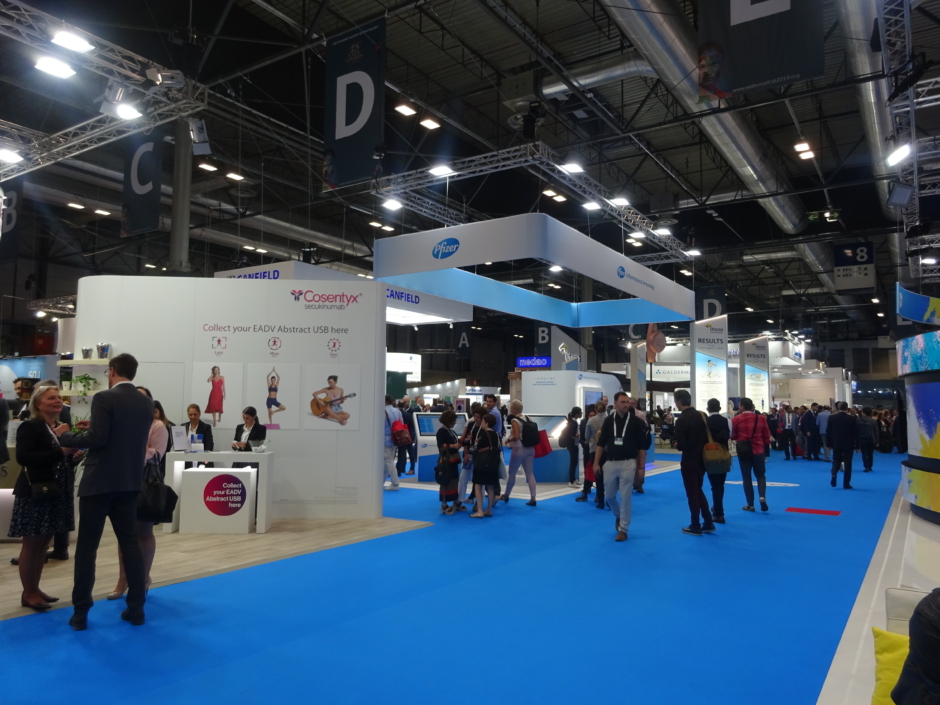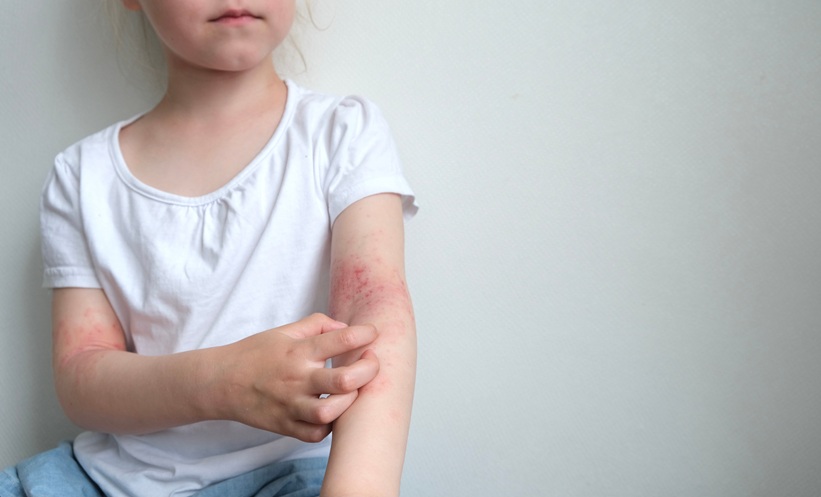Madrid, a city characterised by elegance and culture, welcomed an influx of dermatologists this Autumn for the annual European Academy of Dermatology and Venereology (EADV) congress, now in its 28th year. The city, with its perfectly manicured gardens and cobbled side streets, bustling with tourists and locals alike, hosted the event for the first time. Complete with a cornucopia of both historical and modern architecture, Madrid created the perfect backdrop for the congress which is ‘the modern face of dermatology.
In the opening ceremony, EADV President Carle Paul highlighted the association’s vision and mission, as the leading community to further the knowledge of healthcare
professionals in the field of dermatology. They are dedicated to patient care and education; their mantra is to share, learn, and believe. After an inspiring talk from Ignacio Hernández Medrano on artificial intelligence and healthcare and the world of opportunities this presents, the opening ceremony ended with a quintessentially Spanish flamenco performance.
From the array of poster and abstract presentations that were on offer to delegates at EADV this year, we have hand-picked a selection to feature in our review of the event. The abstract summaries were provided by the authors themselves, offering a first-hand account of the research for our readers. Topics include the treatment of acneiform rash, dermatomyositis revealing the recurrence of bladder cancer, and methods of analysis of the demodex mites’ diagnosis.
As always, a wealth of late breaking research was released at the congress, and our review contains an array of stories covering the press releases. Topics this year included the risk of hair loss posed by air pollution and the impact of dietary habits on acne. One piece of research of particular interest considered the location of malignant melanoma playing a role in the risk of cancer spreading to other parts of the body: tumours found above the neck showed a higher rate of spreading.
Psoriasis featured in a lot of the late-breaking research at EADV, such as the study on anxiety in psoriasis patients who were undertreated and underdiagnosed. The researchers found that more than half of patients with >20% body coverage were not visiting a physician. Psoriasis was also considered in the context of nonalcoholic fatty liver disease, the severity of which could be related to severity of the skin condition.
Within the 166 sessions available for attendees to consume, a standout topic was building the patient–doctor relationship through effective communication. Sessions covered supporting the mental health of patients, best practice of communication to achieve the optimal doctor–patient relationship, and the consequences of poor doctor–patient communications. We cover this topic in more detail in our congress feature.
With so many experts in dermatology in one place, the possibilities of sharing of knowledge and collaboration are fruitful at EADV. We interviewed Prof Alin Tatu who shared his thoughts on the challenges of the field, areas of the field that deserve more attention, and the key take-home messages from the congress. Prof Tatu also discussed some research he published last year on the ‘butterfly effect’ in dermatology and the future of rosacea treatment.
The EADV 2019 congress was another incomparable event in the field of dermatology. Looking ahead to next year, Vienna will play host to dermatologists from all over the world as EADV celebrates their 29th annual event in the Austrian capital. For now, for those who missed the brilliant EADV in Spain this year, or for those who attended but want to relive the highlights, we present our review of the unmissable 28th EADV Congress 2019.
Air Pollution Poses Hair Loss Risk
POLLUTION could be a cause of hair loss in areas where the ambient air quality is particularly poor. This is according to findings presented at the 28th EADV Congress in Madrid, Spain, and reported in a press release dated 9th October 2019. This study is novel in that it is the first to question the connection between air pollutants and hair loss.
Air pollution is suggested to be responsible for 4.2 million deaths globally each year and hence is an area of increasing public interest. This research was led by Dr Hyuk Chul Kwon of the Future Science Research Centre, Seoul, Republic of Korea, who exposed human follicle dermal papilla cells for 24 hours to varying concentrations of particulate matter (PM), which is defined as the solid particles and droplets in the air, such as dust and diesel particulate. Dr Kwon and his team measured levels of the protein β-catenin, known to stimulate hair growth and morphogenesis, as well as cyclin D1, cyclin E, and cyclin-dependent kinase 2 (CDK2), all of which are involved in cycles of hair growth and retention.
PM is divided into categories based on size; PM2.5 relates to particulate diameters of 2.5 μm and PM10 refers to particulate diameters of 10 μm. The researchers found that, after western blot analysis, PM10-like dust and diesel particulate presence resulted in decreased levels of β-catenin, cyclin D1, cyclin E, and CDK2. The burning of fossil fuels, including petrol, diesel, coal, oil, and biomass, is largely held accountable for the increasing levels of PM10.
Dr Kwon sought to discover more about the harmful dermatological effects of PM. He noted that “while the link between air pollution and serious diseases such as cancer, chronic obstructive pulmonary disorder, and cardiovascular disease are well established, there is little to no research on the effect of particular matter exposure on the human skin and hair
in particular.”
Dietary Habits Could Be Key Acne Trigger
ACNE could be associated with poor dietary habits, according to findings presented at the 28th EADV Congress in Madrid, Spain, and reported in a subsequent press release dated 9th October 2019. Analysis of 6,700 participants across North America, South America, and Europe revealed the influence of several worsening factors associated with acne; the most prominent being daily consumption of sweet and typically
unhealthy foods.
The research, led by Professor Brigitte Dréno of the University Hospital of Nantes, Nantes, France, focussed on both internal and external factors, known as the exposome, which affect the severity and response to acne treatment. Results showed that, upon comparing individuals with acne, 37.0% consumed pastries and chocolate daily compared to 27.8% who did not. Other statistically significant results (p<0.001) include 48.2% of patients consumed dairy products daily, versus 38.8% who did not, and 35.6% consumed soda juices or syrups daily, compared to 31% who did not. The researchers also compared patients with and without acne and found that 11.0% of acne sufferers consumed whey products compared to only 7.0% without acne, and 11.9% consumed anabolic steroids compared to 3.2% without acne. In opposition to previous findings, no such association was observed with tobacco.
Acne is one of the most common diseases in dermatology and is estimated to be the eighth most prevalent disease worldwide. Studies have suggested acne increases anxiety levels, leads to feelings of social isolation, and sufferers are even at a disadvantage when it comes to being selected for employment. Additional results of this study found that pollution exposure and harsh skincare routines were other exposome factors. Therefore, knowledge of these exposome stressors is crucial to understanding the disease and its treatment. Dr Dréno is hopeful for the future of acne management and treatment efficacy, and believes that “for the first time, this study allows us to identify the most important exposome factors relating to acne from patient questioning prior to any treatment prescription.”
Families of Atopic Dermatitis Patients at Risk of Depression and Anxiety
ATOPIC dermatitis (AD), a manifestation of cracked and itchy skin, affects around 10–20% of the paediatric population in Europe, constituting a significant therapeutic challenge. Whilst the dermatology community has invested extensive effort into treating these patients, little research has been done into the psychological impact of the condition on family members and caregivers. Now, results have emerged from a press release dated 10th October 2019 at the EADV Congress in Madrid, Spain, showing a significant link to depression in adults for whom children have AD.
In the analysis, the impact of AD was observed in the families of 35 children aged 1–6. The Hamilton Depression and Anxiety Rating Scales (HDRS and HAM-A, respectively) were used in the investigation alongside personal questions pertaining to concerns the participants had. Of the 35 family members and caregivers evaluated, all were found to report at least mild severe anxiety; a proportion of these presented symptoms of moderate severity anxiety. Alarmingly, 74% of the family members and caregivers appeared to show depressive symptoms, which alongside the anxiety scores were attributed to the persistence and longevity of AD in their children or care recipient as opposed to severity of the disease. Often the greatest worry the participants had was related to the information they received regarding disease nature, especially considering the long-term nature of the condition.
Complementary to physical symptoms, AD can be characterised by psychosocial stress, insomnia, and anxiety in patients. It is therefore understandable that the parents or caregivers of those affected will acquire some of this burden, leading to a situation in which entire families are in need of increased support. Lead researcher Dr Vesna Grivcheva-Panovska from the PHI Clinic of Dermatology, London, UK, provided her thoughts on the results: “In the future, we must take a wholesome view of the situation and a widened approach the management of AD not only of the patients but of their families as well.”
Mismanagement and High Levels of Anxiety Reported in German Psoriasis Patients
AFFECTING at least 100 million individuals worldwide, psoriasis is an extremely common and noncommunicable skin disease of which a precise cause is unknown. Released in a press release dated 11th October 2019 at the EADV 2019 Congress in Madrid, Spain, a group of German researchers have presented findings showing that, in a large patient cohort, feelings of mismanagement, undertreatment, and anxiety were abundant.
In the study, 650 psoriasis patients in Germany were asked questions pertaining to their satisfaction with their treatment and their general mental wellbeing and day-to-day life. Fifty-six percent of patients with >20% of their body surface psoriasis-affected reported not currently receiving advice or treatment from a doctor, indicative of poor patient–doctor communication and involvement. Forty-nine percent of patients expressed that their prescribed drugs did not appear to help with their condition, whereas 29% reported excessive numbers of side effects.
The investigators believe that despite the prevalence and profile of psoriasis, more attention needs to be given to developing appropriate treatment strategies to address patient needs; only doing this can the healthcare community avoid the neglection of patients currently dissatisfied with their disease management and doctor involvement. Lead researcher Maximilian Schielein from Ludwig-Maximilians-Universität München, Munich, Germany, concluded from the study that “reaching out to these patients is essential, and healthcare professionals have a duty of care to ensure that everyone with psoriasis receives optimal care.”
An additional study discussed at EADV bolstered this message, revealing that 77% of acute stage psoriasis patients had anxiety disorders (this was compared to 19% in the general population). A need for interdisciplinary diagnosis and treatment approaches, as well as incorporation of psychosocial interventions, was highlighted as one course of action to take to improve the day-to-day life of these patients.
Severity of Psoriasis Related to the Severity of Non-Alcoholic Fatty Liver Disease
SEVERE psoriasis in patients who also have nonalcoholic fatty liver disease (NAFLD) were shown to have greater damage to the liver compared to individuals with milder forms of the skin condition. This is according to findings presented in a press release dated 10th October 2019 at the 28th EADV Congress in Madrid, Spain.
The study recruited 64 male patients who had a mean age of 53.4 years. The Psoriasis Area and Severity Index (PASI) Score was used to diagnose the severity of the psoriasis exhibited by each of the men. Each participant also had a diagnosis of NAFLD which was detected using ultrasound elastography. Measurements provided by ultrasound elastography also gave an indication of liver tissue stiffness, typically associated with NAFLD or liver fibrosis which can consequently lead to cirrhosis and end-stage liver disease.
Dr Daniel Nieto, lead researcher of the study, from La Paz Hospital in Madrid, Spain, presented the results at EADV 2019. He commented on the critical link between the two diseases: “Previous research has already established a link between psoriasis and NAFLD. This is one of the first studies to assess the relationship between the severity of psoriasis with the severity of NAFLD.”
A separate study conducted in Iran also investigated this link, and the results corroborated with the results presented by Dr Nieto and his peers at the congress in Barcelona. The study in Iran comprised 54 male participants with
psoriasis and NAFLD. The results of the study proposed that those with high-grade psoriasis
had a greater degree of severity of NAFLD. The severity of the NAFLD also had a positive correlation with the degree of psoriasis assessed using the PASI Score. The positive correlation may be due to proinflammatory cytokines and adiopocytokines which trigger psoriasis, contributing to worsening of the disease. The data was analysed using SPSS16 statistical software, chi-square, and the Fisher exact test.
“In this context, increasing awareness and the continued assessment of the severity of NAFLD in patients with psoriasis by primary care physicians, specialists, health policy makers and patients, should be prioritised to help manage both conditions.”
Malignant Melanoma Above the Neck Has Higher Chance of Spreading
SKIN cancer that develops on the neck has an increased chance of spreading than that which is found below the neck, as shown in results from a 6-month study presented at EADV in Madrid, Spain, and reported in a press release dated 11th October 2019. Within the study, computed tomography was used to assess the presence and spread of cancer and determine whether location played a role.
Researchers studied 45 patients, who had new diagnoses of malignant melanoma (MM), over a 6-month period, with the aim of identifying whether location of MM was linked with likelihood of the tumour metastasising. A significantly higher portion of the patients had below neck MM (n=37) compared with 8 patients who presented with MM above the neck.
Results showed that none of the 37 below neck tumour patients had distant metastases. One patient in this group was found to have positive nodes (2.7%). Within the above neck group, two of the eight patients displayed positive nodes
and distant metastases (25.0%). The authors drew the conclusion that MM above the neck had a higher chance of spreading when compared to MM found below the neck.
Of all the types of skin cancer, MM is the most dangerous and is increasingly common. As MM spreads deeper within the skin, treatment becomes considerably more challenging, and the cancer can be deadly. The melanoma BRAF V600 gene can also undergo mutations, which impact the BRAF protein production and cause an increase in cell growth rates.
Lead researcher Dr Mohammed Al Abadie, Royal Wolverhampton NHS Trust, Wolverhampton, UK, discussed the study: “A mutation in the gene encoding BRAF has been well demonstrated to occur in association with MM, and this has revolutionised further management in patients with advanced disease. In this study, we have reviewed new MM diagnoses to see which ones are more likely to metastasize in terms of location. Understanding more about these locations also may help to determine and manage a
patient’s survival.”
Identification of The Most Influential Exposome Factors on Acne
RANKING of exposome factors affecting acne can now be established, according to the results of a study presented as part of a press release dated 12th October at this year’s EADV congress in Madrid, Spain. The exposome is the totality of human environmental exposures, the sum of internal and external factors impacting the onset, duration, and severity of acne.
The study comprised an online international study in France, Germany, Italy, Brazil, Canada, and Russia. The French authors of the study recruited 10,040 individuals, who were required to complete questionnaires based on six exposome factors explained by Dréno B et al; resultantly, two study groups were created. Eligible participants in the acne group met specific criteria: exhibiting clinically diagnosed acne; or, receiving prescription for the treatment of acne by a clinician. A multivariate regression logistic analysis was performed and adjusted for age and gender.
Environmental factors monitored in 6,679 eligible participants included: daily consumption of dairy products, soda, chocolate, and sweets; frequent nibbling, use of harsh cleansers or peelings; regular whey protein consumption, and expressions of feeling stressed. In the acne group (n=2826), consumption of dairy products, sweets, nibbling, alcohol, cannabis, whey proteins, stress levels, and exposure to pollution were the exposome factors observed more often than in the control group (n=3853). The use of a dermo-roller or harsh cleanser were significantly more frequent in the acne group. Tobacco is widely considered to be a trigger of the disease; however, it did not generate significant results in this present study.
Under ‘real-life’ conditions, a total of ten of the exposome factors explored in this study had a significant impact on acne within the participants. The present study affirmed the role of nutrition, harsh skincare, stress, and whey protein consumption on acne. The study was able to clarify the most potentially influential exposome factors on acne, which may have a direct effect when considering options prior to treatment.








